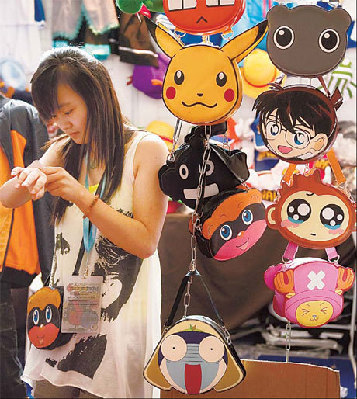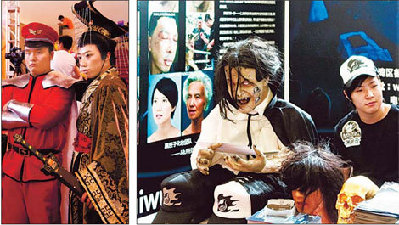Chasing creativity in cartoons
After importing cartoon series for TV for more than 20 years, China is determined to develop its own animation industry. But China's potential Walt Disneys are yet to find their Mickey Mouse.
|
|
|
Instead of income from TV stations, domestic cartoon makers expect to make more profit from derivative products. Photos By Yong He / For China Daily |
The nation imported a large number of cartoons from 1981 to 2004. But the policies implemented since then to encourage the domestic animation industry has shown impressive results, with China's cartoon production of the past year alone amounting to half of the total production of the previous decade, says Jin Delong, a PR officer with China's showbiz watchdog, the State Administration of Radio, Film and Television (SARFT).
He was speaking at the sixth edition of the China International Comics and Games Expo (ICG Expo) held recently in Shanghai.
However, this still cannot mask some serious problems in China's animation industry. It lags far behind those countries where animation is highly developed, such as Japan and South Korea, says Liu Yuzhu, an official from the Ministry of Culture.
Liu listed a number of problems at the forum on animation and derivative industries at the ICG Expo. Many training institutions and enterprises have been founded without taking a long-term view, he said. Local cultural administrations were excited at the seeming prosperity of the animation industry, without realizing that they had neither the resources nor the market for it. Also, many places lack good teachers and creative talents. All this has contributed to poor product quality.
"They may produce 3,000 minutes of cartoon, but a lot of it will never appear on TV screens - they simply do not meet the quality standards," says Chen Yingjie of an investment company under the Shanghai Media Group (SMG).
A cartoon industry insider, who preferred to be anonymous, did the math for Chinese cartoon makers: TV stations in China will pay no more than 500 yuan ($74) for each minute of cartoon, and of the 35 TV stations that show cartoons, only a few are ready to pay this price. On the other hand, good quality cartoon entails per-minute costs of at least 10,000 yuan - many cartoon makers try to limit their producing cost to 1,000 yuan per minute because that equals the amount of subsidy the company can expect to get from the government for each minute of its product that gets shown on TV.
SARFT issued a circular in 2004, decreeing that at least 60 percent of cartoons shown on TV should be domestically produced. It banned foreign animated films from being shown from 5 pm to 8 pm in 2006 and extended this to 9 pm in 2008.
According to Chen, however, this ban on foreign cartoons has only harmed the market - when you are forced to show low-quality cartoons, nobody will watch and you simply get no advertisements.
In contrast to the tight control of foreign cartoons on TV, many animated movies have had outstanding box-office success in the Chinese market, which proves the market potential for good animation.
"I'm ready to pay more for high quality cartoons for my child," says Hu Yan, a Shanghai mom of an eight-year-old boy. "I'd take my son to the cinema for a good cartoon movie, such as Shrek and Toy Story. Of course, I would like to see more good Chinese cartoons so that the younger generation becomes familiar with Chinese culture."
Since 2006, the government has invested 200 million yuan ($29.5 million) annually in the cartoon industry, and last July, also introduced a favorable tax policy.
"That is why domestic cartoon makers are so keen on derivative products," Chen says. "They want the stuffed toys and merchandize bearing the image of the cartoon figures to make more profit."
|
|
|
Cosplay costume and souvenirs on display at Shanghai's China International Comics and Games Expo. |
But China lacks the management talents to integrate all three parts of the cartoon industry - from the creative initiative to the actual production process and management of derivative products, Jin says.
"We do encourage international communication and collaboration," the official with SARFT counters, "so that we can learn about such things as integrating the three parts."
China's cartoon technology and craftsmanship is up to international standards, and many Hollywood large-budget cartoon movies are produced in China, he says.
However, it is obvious that no money can be made from derivative products if the cartoon itself is not popular with the audience.
Ronnie Del Carmen, a storyboard supervisor with Pixar told China Daily that he was impressed with the 1964-made Chinese cartoon Monkey King. The Philippines-born artist has been involved in the production of such Pixar Cartoons as Up, Wall E, Finding Nemo and Ratatouille.
He believes the success of a cartoon has more to do with good storytelling than with spectacular visual effects. "When you create a scene that audiences can relate to, when they can feel for the character and even recognize themselves in the characters, you know it works," he says.
Although some cartoon movies featuring Chinese stories or characters have achieved global success in recent years, such as Kungfu Panda and Mulan, these were all produced by American studios, and were sometimes criticized by Chinese audiences for not having an authentic flavor.
"This can be easily solved by having more Chinese in the creative team," says Pietro Ventani, co-founder of Tiger 62 Media, who has been supervising the marketing of The Forbidden Kingdom starring Jackie Chan and Jet Li.
"You can create stories that you feel are authentic, but at the end of the day it has to find an audience that will respond to the story emotionally," says Ventani. Encouraged by the successful experience of working with Chinese partners on The Forbidden Kingdom, Ventani is once collaborating on a new movie titled Chinese Odyssey.
Although SARFT encourages international collaboration in making cartoons, SMG's Chen says it was very difficult to get its clearance.
A spokesman surnamed Fan with the Huanwei Animation Company under SMG, meanwhile, says the protective policies have helped domestic companies. "We surely can't afford to pay our cartoon makers the same as Pixar or Disney," he says. "Without the subsidy and protective regulations, nobody in China will be making cartoons - the industry will simply die out."




















